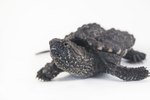Things You'll Need
5-gallon plastic container or aquarium
Submersible water heater with thermostat
Cup
Water
Sand (enough to fill 5-gallon tub)
10-gallon aquarium
2 thermometers
Sheet of Plexiglas
Drill
Tape
Turtle eggs often benefit from the help of an incubator. According the World Chelonia Trust’s website, captive turtle eggs rarely hatch when left alone in nests because the conditions are rarely the same as those found in the natural environment. Luckily for turtle owners, a simple aquarium may be adapted to create an effective turtle egg incubator. It is also important to understand that different turtle species have various incubation periods, so knowing which type of turtle eggs are being incubated may help you properly care for them.
Fill the 5-gallon container with sand. Pour cups of lukewarm water over the sand to wet it, but do not leave the sand overly damp. Place a thermometer into the center of the sand about 1 inch deep.
Place the 5-gallon container and the aquarium water heater into the 10-gallon tank. Set the water heater to 80 degrees but do not turn it on.
Fill the 10-gallon tank with lukewarm water until the water level is about 1/2 inch above the sand line in the 5-gallon container. Place the second thermometer into the outer tank. Turn on the water heater.
Drill five to six holes in the Plexiglas sheet. Each hole should be about 1/4 inch in diameter. Place the Plexiglas sheet over the tanks.
Monitor the temperature in the tanks for several days. Record the temperature every few hours and chart the changes between day and night temperatures. The temperature in both tanks should hover around 82 degrees Fahrenheit.
Make indentations in the sand to prep the tank for the eggs. Place eggs in the sand until they are about halfway covered. Leave eggs alone to allow them to incubate and continue to monitor the temperature and water levels in the tanks to keep them steady.
Tips
Research the incubation times for the specific turtle species to ensure the eggs are given the proper amount of time to incubate. Should water begin to collect on the Plexiglas sheet, drill a few more holes to help lower the humidity in the incubator.





